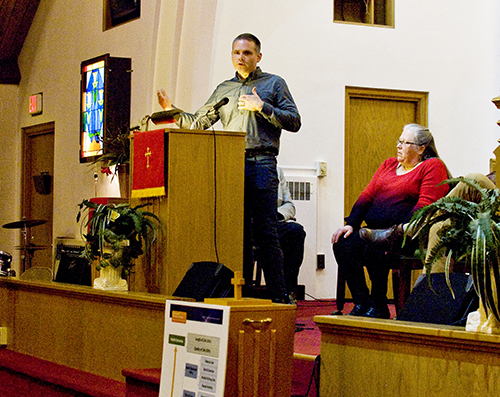
Kathy Triantafillou, left, environmental justice coordinator for U.S. EPA Region 5, and Matthew Tejada, director of the office of Environmental Justice for the U.S. EPA in Washington, pass the smokestacks at the E.D. Edwards coal-fired power plant on a bus tour of toxic sites in the Peoria area sponsored by Illinois People’s Action, Heart of Illinois Sierra Club and Central Illinois Healthy Community Alliance among other groups Tejada pledged to help leverage $8.6 million in benefits earmarked in a court settlement to shutter the plant in 2022. (PHOTO BY CLARE HOWARD)
Robin Nolting felt a jumble of emotions when U.S. Federal Judge Joe Billy McDade announced in court that he will accept a compromise agreement in a lawsuit filed by environmental groups against Vistra Energy calling for the closure of the E.D. Edwards coal-fired power plant near Nolting’s home.
For decades, Nolting has battled the coal soot and particulate pollution that blanketed her home and surrounding areas. She had to learn infant CPR when her daughter was born. The two ended up in the emergency room with severe asthma attacks hundreds of times. The swing set in her yard was always covered with soot and houses in her neighborhood were always dark with soot.
Nolting said when her daughter was growing up, all her friends had asthma inhalers. When her daughter moved to Chicago for college, her asthma attacks ended, Nolting said.
Nolting was in court when Judge McDade announced his decision in mid-November.
McDade said he accepted the compromise agreement calling for $8.6 million in workforce, environmental and public health programs because he felt it was fair to all parties.
The Edwards plant has racked up thousands of violations of the federal Clean Air Act.
McDade cited media accounts that contended recent Vistra plant closings failed to include Edwards because it was more profitable to operate since it had not installed environmental safeguards. He also specifically cited the $1.6 million and three-year window before the plant shutdown in 2022 to allow for job retraining. About 70 people work at plant.
Vistra did not respond to a request for comment, nor did the union representing workers at the plant.
McDade said the Edwards plant represents $62 million for the Peoria area but acknowledged the burden of air pollution falls primarily on the poor and less well off people.
He said the $7 million called for in the agreement could be allocated for electric vehicles, schools, energy efficiency programs, public education, solar development and more.
“This is a good compromise and in the best interest of the public,” he said in announcing his decision. “This will mitigate harm to those employed there.”
The day prior to the court’s ruling, local environmental groups organized a bus tour of toxic sites in the Peoria area. On the tour was Matthew Tejada, director of the office of environmental justice with the U.S. EPA.
Tracy Fox, with Central Illinois Healthy Community Alliance and Illinois People’s Action, said her parents and grandparents lived on the Peoria South Side and were exposed environmental toxins for decades. The area is a food desert. Many vacant and abandoned homes dot the neighborhood. Many houses have high levels of lead. The 61605 zip code is one of the poorest in the state and the nation. There is so much lead in the soil that vegetable gardens must be planted in raised beds with purchased soil.
Tejada pledged to try to help leverage money from the court settlement closing the Edwards plant to find more financial resources for tackling pollution issues in Peoria’s South Side.
An evening meeting following the bus tour was hosted by Mt. Zion Baptist Church and the Rev. Alphonso Lyons Jr.
In opening remarks, the Rev. Tony Pierce, chairman of the board of Illinois People’s Action, called on government to stop sacrificing people to pollution.
“In Peoria, we know about environmental injustice,” he said, much caused by coal burning at the Edwards plant.
“Infants have to fight to draw a breath . . . and our own government has allowed Edwards to violate us (the Clean Air Act) not once, but more than 6,000 times.”
Monica Hendrickson, public health administrator with the Peoria City/County Health Department, said “There is a relationship between public health and environmental health.”
Any upfront costs to tackling environmental pollution are far less than the costs of impaired health and environmental remediation, she said.
Children living on Peoria’s South Side have asthma at six times the rest of the state, she said.
Fox told the audience that the Illinois Pollution Control Board has allowed polluters to do more for their own pocketbooks than for the people.
Fox called for more job retraining and green jobs.
The Heart of Illinois Sierra Club called a community meeting with the first session from 4 to 5 p.m. and the second session from 6 to 7 p.m. Dec. 3 at the Peoria Downtown Library to assess plans following the court settlement.
Nationwide, however, air pollution from fine particulate matter has increased dramatically since 2016 when government regulations were significantly weakened.
According to statistics from researchers at Carnegie Mellon University, fine particulate pollution has increased 5.5% on average nationwide since 2016 after declining almost 25% over the previous seven years.
In the Midwest, research documented a 9.3% increase over that same period.
The economic cost of this increase in air pollution was estimated at $89 billion a year. The increase is also linked to nearly 10,000 additional premature deaths.
“After a decade or so of reductions, this increase is a real about face,” said Nick Muller, a professor of economics, engineering and public policy at Carnegie Mellon and one of the study’s co-authors.
The fine particulate pollution that sent Robin Nolting’s daughter to the emergency room hundreds of times measures less that one-thirtieth the size of a human hair and is linked to asthma, respiratory inflammation, lung cancer, heart attacks, strokes and miscarriages.
New York Times columnist Paul Krugman has written, “Follow the money. There’s huge variation among industries in how much environmental damage they do per dollar of production.”

Director of the office of environmental justice at the U.S. EPA Matthew Tejada, tells nearly 200 people meeting at Mt. Zion Baptist Church that it is people’s advocacy that will force changes in public policy. -PHOTO BY CLARE HOWARD

Recent Comments